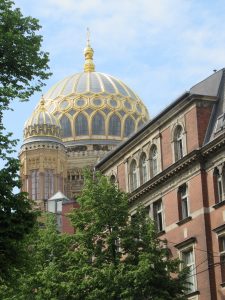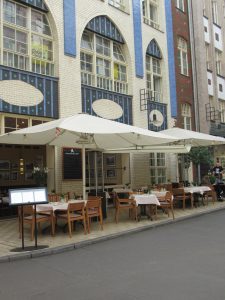Jews first settled in Berlin centuries ago and their culture has marked the city profoundly. A previous blogpost was about the holocaust and remembrance in Berlin; this one covers the places in the city where you can learn more about Jewish culture, history and heritage. You might be surprised how many there are!
Jews in Berlin: A Little History

In 1671, 50 Jewish families were invited to Berlin by Friedrich Wilhelm, Duke of Prussia after their expulsion from Vienna and they settled in an area north of Alexanderplatz known as the Scheunenviertel. Two centuries later, their numbers had grown hugely and in 1866 the New Synagogue was opened in Orianenburger Strasse, a splendidly ornate building where 3000 people could worship. Its golden dome is still a landmark in this corner of the city, but the building was badly bombed during World War II, then reopened as a centre of Jewish heritage so it’s an excellent place to start learning about Jewish culture in Berlin. Two informative books on the story Of Jews in Berlin are The Wandering Jews by Joseph Roth and Jews in Berlin by Andreas Nachama.
The New Synagogue
The history of the New Synagogue is told through artefacts: a wood carving of the grand opening on Rosh Hashana in 1866, a scale model of the original building, the Torah desk, partially reconstructed from fragments, a description of the damage done during the night of the pogrom in 1938: ‘‘The interior hall was trashed, the Ark broken open, the Torah scrolls desecrated and the building set ablaze.’ Wilhelm Krützfeld is remembered with gratitude. He was a policeman on duty that night and he called the fire brigade in time to prevent the complete destruction of the synagogue. It then re-opened for Passover in 1939, only to be closed by the Nazis in 1940.

The exhibition also gives glimpses of those who worshipped here. Brothers Julius and Adolph Jacoby married sisters Lydia and Cecilia Schönlank and when the New Synagogue opened in 1866, the two couples donated the sanctuary lamp which hung in front of the Torah Ark. A photograph shows the wedding, in December 1939, of Rabbi Heinz Meyer and Ingeborg Silberstätter, one of the last couples to marry under the wedding canopy, or chuppah. Their story is bleak: they were deported in May 1943 and both were murdered in concentration camps, he at Dachau and she at Auschwitz. A memorial wall explains that of the 160,000 Jews living in Berlin in 1933, 90,000 escaped Germany. The names of 50,576 Jews who were abducted from Berlin and died in the camps are all here, with the explanation: ‘Every Person has a name. The Jewish victims of National Socialism in Berlin.
Hakesche Höfe

The Hakesche Höfe is a little area just near Alexanderplatz which was originally a series of courtyards built in 1906 where many of Berlin’s Jewish population lived. Today, the courtyards have been renovated and contain a mix of housing, shops, galleries, restaurants and a little Kino-Theater, popular with Berliners and tourists alike. Look out for the wonderful Art Nouveau façade in courtyard number one and for various plaques recalling the area’s history, such as one in memory of the Jewish Reformer, Rabbi Abraham Geiger.
Otto Weidt Museum and Anne Frank Centre

These are just next door to the Hackesche Höfe. The Otto Weidt Museum is in the former Blindenwerkstatt, a workshop employing blind people, many of them Jewish, where Otto Weidt hid some of his employees to try and save them from persecution by the Nazis. In the same building, the Anne Frank Centre tells her story through an exhibition called ‘All about Anne’. This exhibition and cultural centre also runs guided tours of the area (see below)
The Old Jewish Cemetery

The city’s original Jewish Cemetery on Grosse Hamburger Strasse, was built on land given to early Jewish settlers in the 17th century. Among those buried there are the Enlightenment philosopher Moses Mendelssohn, often called the German Socrates. The cemetery was closed in 1794, when it was decided the dead should no longer be buried within the city walls, but a turbulent history followed. A memorial sculpture and plaque bear witness: a Jewish Old People’s Home, built here in 1844, was used as a holding camp for Jews rounded up by the Nazis and the cemetery was destroyed in 1943. Gravestones were smashed, bodies pulled out of the ground and mass graves dug for those killed in wartime street fighting. After the war, the cemetery was returned to the Jewish community.
The Jewish Cemetery at Schönhauser Allee

This Jewish Cemetery replaced the cemetery in Grosse Hamburger Strasse when it was closed. The 25,000 graves lie peacefully among trees, but many of the details to be uncovered are poignant. One memorial plaque is dedicated to 35 Jewish men who died in World War I, fighting for a country which was to betray their descendants a generation later. Another recalls Wehrmacht soldiers who tried to desert in World War II and were caught by the Gestapo and hanged from the trees as punishment. On the back wall is a plaque, typical of so many, which reads ‘Zum Gedächtnis an unsere Kinder’ – ‘In memory of our children’ – and records the deaths at Theresienstadt and Mauthausen of Ruth Veit Simon, her brother Rolf Veit Simon and (presumably) Rolf’s wife, Sabine Veit Simon. All were in their twenties when they were murdered.
The Jewish Museum

The Jewish Museum building is itself a work of art, its zig-zag shape reminiscent of a broken Star of David. At the entrance, you descend a slate stairway into a lower level where there are three corridors, or axes, the Axis of Exile, the Axis of the Holocaust and the Axis of Continuity, representing the different paths Jews were forced to take because of Nazi persecution.

The main displays upstairs are a treasure trove of Jewish history and culture, with sections on Jewish faith (The Torah, Jewish Law, Prayer and Practice), on History (When Jews became Germans, Catastrophe and After 1945) and on culture (Music, Art and Artists and ‘The Jewish Object’) The many exhibits include a needlework sampler from 1810, showing that children learned both the Roman and the Hebrew alphabets. There are letters, family photograph collections, and artwork, including a sketch called ‘Two Women in the Ghetto’ by Gertrud Zuelzer who survived Theresienstadt and told later how she had exchanged some of her drawings for pieces of bread in order to survive. If you have children, don’t miss the special section aimed at them: Anoha, where a huge ark and model animals are used to retell Noah’s story.
Two Walking Tours

The Anne Frank Centre organises walking tours called Discovering Traces of Jewish Life (suitable for age 14 and over) which will take you to many of the places mentioned above and past a number of memorials like the ‘Abandoned Room’ on Koppenplatz and some of the many Stolpersteine, memorial plaques to individual Jews who died in the holocaust which are set into the pavements of the city. Yoav and Natalie Sapir run walking tours with a focus on Berlin’s Jewish history, again taking in a number of sites. ‘Our history tours’, they say, ‘are not just about seeing the sights, but also about understanding them.’
Listen to the podcast
Suggested Reading
The Wandering Jews by Joseph Roth
Jews in Berlin by Andreas Nachama
Links for this post
The New Synagogue
Hakesche Höfe
The Otto Weidt Museum
The Anne Frank Centre
The Old Jewish Cemetery (Hamburger Strasse)
The Jewish Cemetery (Schönhauser Allee)
The Jewish Museum
Otto Weidt Museum
Anne Frank Centre
Walking Tour (Discovering Traces of Jewish Life)
Walking Tour (Jewish Berlin)
Last Updated on January 30, 2025 by Marian Jones






